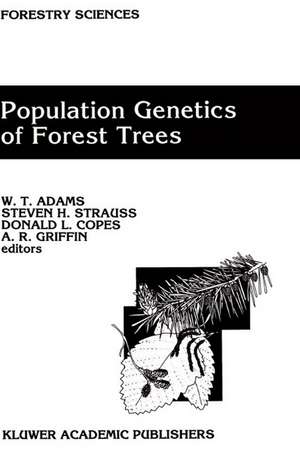Population Genetics of Forest Trees: Proceedings of the International Symposium on Population Genetics of Forest Trees Corvallis, Oregon, U.S.A., July 31-August 2,1990: Forestry Sciences, cartea 42
Editat de W.T. Adams, Steven H. Strauss, Donald L. Copes, A.R. Griffinen Limba Engleză Hardback – 30 noi 1992
| Toate formatele și edițiile | Preț | Express |
|---|---|---|
| Paperback (1) | 1223.25 lei 6-8 săpt. | |
| SPRINGER NETHERLANDS – 23 oct 2012 | 1223.25 lei 6-8 săpt. | |
| Hardback (1) | 1229.58 lei 6-8 săpt. | |
| SPRINGER NETHERLANDS – 30 noi 1992 | 1229.58 lei 6-8 săpt. |
Din seria Forestry Sciences
- 18%
 Preț: 958.56 lei
Preț: 958.56 lei -
 Preț: 388.13 lei
Preț: 388.13 lei - 15%
 Preț: 644.18 lei
Preț: 644.18 lei - 18%
 Preț: 1848.16 lei
Preț: 1848.16 lei - 18%
 Preț: 2105.44 lei
Preț: 2105.44 lei -
 Preț: 390.25 lei
Preț: 390.25 lei - 18%
 Preț: 950.33 lei
Preț: 950.33 lei -
 Preț: 390.84 lei
Preț: 390.84 lei - 18%
 Preț: 1226.73 lei
Preț: 1226.73 lei -
 Preț: 383.50 lei
Preț: 383.50 lei - 18%
 Preț: 950.33 lei
Preț: 950.33 lei - 18%
 Preț: 1234.77 lei
Preț: 1234.77 lei - 15%
 Preț: 637.28 lei
Preț: 637.28 lei -
 Preț: 387.58 lei
Preț: 387.58 lei -
 Preț: 385.62 lei
Preț: 385.62 lei - 18%
 Preț: 952.72 lei
Preț: 952.72 lei - 18%
 Preț: 1219.63 lei
Preț: 1219.63 lei - 18%
 Preț: 1229.73 lei
Preț: 1229.73 lei - 15%
 Preț: 647.59 lei
Preț: 647.59 lei - 18%
 Preț: 949.73 lei
Preț: 949.73 lei - 18%
 Preț: 946.10 lei
Preț: 946.10 lei - 18%
 Preț: 2762.55 lei
Preț: 2762.55 lei - 15%
 Preț: 644.95 lei
Preț: 644.95 lei - 18%
 Preț: 1840.26 lei
Preț: 1840.26 lei - 18%
 Preț: 1228.15 lei
Preț: 1228.15 lei - 18%
 Preț: 1236.69 lei
Preț: 1236.69 lei - 15%
 Preț: 639.73 lei
Preț: 639.73 lei - 18%
 Preț: 1847.21 lei
Preț: 1847.21 lei
Preț: 1229.58 lei
Preț vechi: 1499.49 lei
-18% Nou
Puncte Express: 1844
Preț estimativ în valută:
235.31€ • 244.76$ • 194.26£
235.31€ • 244.76$ • 194.26£
Carte tipărită la comandă
Livrare economică 14-28 aprilie
Preluare comenzi: 021 569.72.76
Specificații
ISBN-13: 9780792318576
ISBN-10: 0792318579
Pagini: 423
Ilustrații: VI, 423 p.
Dimensiuni: 170 x 244 x 24 mm
Greutate: 0.79 kg
Ediția:1992
Editura: SPRINGER NETHERLANDS
Colecția Springer
Seria Forestry Sciences
Locul publicării:Dordrecht, Netherlands
ISBN-10: 0792318579
Pagini: 423
Ilustrații: VI, 423 p.
Dimensiuni: 170 x 244 x 24 mm
Greutate: 0.79 kg
Ediția:1992
Editura: SPRINGER NETHERLANDS
Colecția Springer
Seria Forestry Sciences
Locul publicării:Dordrecht, Netherlands
Public țintă
ResearchCuprins
Dedication.- Keynote paper.- Genetic diversity - seeing the forest through the trees.- Assessment of genetic diversity within and among species.- Genetic variation within European tree species.- Patterns of genetic diversity in Australian tree species.- Isozyme variation in tropical trees: patterns of genetic organization.- Factors influencing levels of genetic diversity in woody plant species.- Biosystematics and adaptive significance of biochemical markers.- Biochemical and molecular genetic markers in biosystematic studies of forest trees.- Applications of terpene analysis in forest genetics.- Evidence for the adaptive significance of allozymes in forest trees.- Mating systems, gene dispersal, and genetic structure within populations.- The dynamic mating systems of conifers.- Gene dispersal within forest tree populations.- Gene flow among seed plant populations.- Spatial structure of genetic variation within populations of forest trees.- Application of biochemical markers in forest management.- Allozyme markers in breeding zone designation.- The use of electrophoretic markers in seed orchard research.- Effect of forest management on gene pools.- Allozyme markers in forest genetic conservation.- DNA as a biochemical marker.- Nuclear, chloroplast, and mitochondrial DNA polymorphisms as biochemical markers in population genetic analyses of forest trees.- Use of DNA markers in forest tree improvement research.- Commentary.- A commentary on current approaches to forest population genetics.















